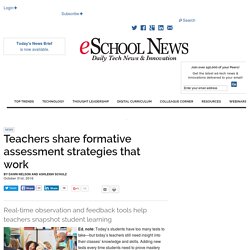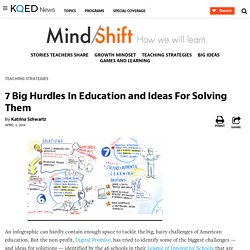

PDCs
Teachers share formative assessment strategies that work. Ed. note: Today’s students have too many tests to take—but today’s teachers still need insight into their classes’ knowledge and skills.

Adding new tests every time students need to prove mastery rarely seems like the right answer. For some classrooms, the solution lies in formative assessments, which gauge their students’ understanding and personalize their lessons in real time. Here, two educators share how formative assessments are transforming their students’ learning across the board. Dawn Nelson, school library media specialist “Formative assessment is an essential part of teaching because it helps guide instruction.
The most helpful methods of formative assessment are those that are easy to implement but still provide the information a teacher needs about whether their students have met their learning targets. Digital tools such as Plickers, Kahoot, or Socrative provide that information but require teacher time to be created and implemented well. How to Determine if Student Engagement is Leading to Learning. Excerpted from the book, “UnCommon Learning: Creating Schools That Work for Kids,” by Eric Sheninger, published by Corwin, 2015.
Engagement Does Not Always Equate to Learning No matter where I am, whether it is a physical location or virtual, I am always hearing conversations about how technology can be used to engage students effectively. This is extremely important as the majority of students spend six to eight hours a day in schools where they are completely disengaged. T. Photo When I was in high school, I earned A’s in all my math classes — until I took calculus.

In algebra and geometry, I could coast on memorizing formulas, but now I had to think for myself. It was disastrous, culminating in my getting a charity “C,” and I barely passed my college calculus class. The reason, I was convinced, was that I didn’t have a math mind. I have avoided the subject ever since. It turns out that I got it wrong. I’m not the only person convinced that he can’t like math.
This fatalistic equation can be altered. Consider these examples from three recent studies: • A cohort of sixth-grade students was taught, in eight lessons, that intelligence is malleable, not fixed, and that the brain is a muscle that grows stronger with effort. . • When an English teacher critiqued black male adolescents’ papers, she added a sentence stating that she had high expectations and believed that, if the student worked hard, he could meet her exacting standards.
Continue reading the main story. Ten Steps to Better Student Engagement. Tristan de Frondeville As a teacher, my goal was to go home at the end of each day with more energy than I had at the beginning of the day.

Seriously. Now, as I travel the country coaching teachers on how to successfully use project learning, my goal remains the same. Dialogue Defibrillators: Jump-Start Classroom Discussions! During a 12th-grade English discussion years ago, I asked a question that nobody answered.

Wanting students to do more heavy academic lifting, I decided to wait until someone spoke before saying another word. A minute crept by. The class fidgeted while I waited. Ninety tense seconds passed. Students' faces registered confusion and frustration at my brinkmanship. 8 Issues and Remedies We've all experienced whole-class discussions where students don't play along. 1. Sometimes students don't respond to a prompt because it's either too complex, ill-structured, or inaudible. Educational Leadership:Strengthening Student Engagement:Strengthening Student Engagement: What Do Students Want. Hattie effect size list - 195 Influences Related To Achievement
John Hattie developed a way of synthesizing various influences in different meta-analyses according to their effect size (Cohen’s d). In his ground-breaking study “Visible Learning” he ranked 138 influences that are related to learning outcomes from very positive effects to very negative effects. Hattie found that the average effect size of all the interventions he studied was 0.40.
Therefore he decided to judge the success of influences relative to this ‘hinge point’, in order to find an answer to the question “What works best in education?” Originally, Hattie studied six areas that contribute to learning: the student, the home, the school, the curricula, the teacher, and teaching and learning approaches. (The updated list also includes the classroom.) Relationships are at the center of how students remember their teachers @sylviaduckworth @lori_gard #edchat. 7 Big Hurdles In Education and Ideas For Solving Them. An infographic can hardly contain enough space to tackle the big, hairy challenges of American education.

But the non-profit, Digital Promise, has tried to identify some of the biggest challenges — and ideas for solutions — identified by the 46 schools in their League of Innovative Schools that are trying new techniques. They address issues like competency-based learning and personalized professional development, as well as students’ ownership of their learning. Click on the image above to see all seven challenges and their solutions. Katrina Schwartz Katrina Schwartz is a journalist based in San Francisco.
Coaching. Curriculum Leaders. School Climate. Tech Tips. Data Resources. Professional Development Resources.